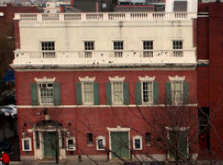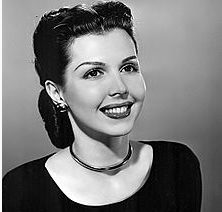HAPPY BIRTHDAY, LAURETTE TAYLOR
(April 1, 1884 - December 7, 1946)
"The theatre was her life."
Born Loretta Cooney, her first public appearances involved declamations of soul-stirring poetic masterpieces such as "The Wreck of the Hesperus," "The Charge of the Light Brigade," and "Curfew Shall Not Ring To-night." Despite her family's objections to a life on the stage as a dreadful thing worthy of eternal damnation or denying that it even existed, it was her mother who approved of a theatrical career and encouraged Loretta to participate in the performing arts program at Public School No. 68 in Harlem.
She appeared in vaudeville where she gave imitations of such personalities as Eddie Foy and Anna Held. After she married Charles Alonzo Taylor, a successful writer and producer of melodrama and twenty years older than his teenaged bride, she spent six years learning every aspect of the stage from making costumes to managing the box office.
In 1901 she acted the soubrette roles in the road company productions of her husband's melodramas for several years until she joined an acting troupe at the Seattle Theatre and debuted in her first long dress part as Marguerite in
Faust. After performing in almost fifty plays and musical comedies, she collapsed from overwork and anxiety. Between 1903 and 1910 she starred in several successful plays and as Rose Lane in
Alias Jimmy Valentine she achieved instant success followed by the role of the Hawaiian princess Luana in
The Bird of Paradise. But in 1912 she won the unqualified admiration of Sarah Bernhardt for her leading role in J. Hartley Manners's play
Peg o' My Heart, which he wrote for her. The play ran for over six hundred performances in New York, and another five hundred in London. In May of 1913 she gave a special 11AM performance for Sarah Bernhardt, who formed an audience of one. Madame Bernhardt predicted "Within five years Laurette Taylor will be the greatest actress on the American stage." (NY Dramatic Mirror, 12/16/1916)
Alexander Woollcott celebrated her as a first-rate actress, claiming that "any role she plays. . . at once becomes so colored by her qualities as a person, so defined by her method, and so complicated by her distinct limitations and her all-conquering charm, that it seems like an invention of her own and begets the ever-recurrent legend that she really does much of the writing herself." (Everybody's Magazine, May 1920)
When her beloved mentor and husband J. Hartley Manners died in 1927, she left the stage for ten years. It is reported that she went on a ten year bender she later called "the longest wake in history." It was her desire to write that pulled her out of her depression. Two of her plays were produced regionally and some short stories and personal sketches appeared in
Vogue and
Town and Country. Then in 1938 she found a role that challenged her imagination--Mrs. Midget in Sutton Vane's
Outward Bound. Her sensitive portrayal of the charwoman-mother of a wayward son revealed to a new generation of theatregoers the magical powers of this great actress. She received critical praise and won the Barter Award in 1939.
When she premiered as Amanda Wingfield in Williams's
The Glass Menagerie on March 31, 1945 her triumph was complete. She had come to terms with herself as well as her character. "You see, the woman I play is really two parts", she told an interviewer. "First she is a shrew. Then she remembers--and you see her as she remembers herself--as a young girl." When asked why she gave Amanda Wingfield bangs she replied "Because, alas, I have too good a brow for a brainless woman--and the woman in the play has no brains."
Lewis Nicholas, theatre critic for the
New York Times, wrote: "She plays softly and part of the time seems to be mumbling--a mumble that can be heard at the top of the gallery. Her accents, like the author's phrases, are unexpected, her gestures are vague and fluttery. There is no doubt she was a southern belle; there is no doubt she is a great actress.' (April 2, 1945).
People, especially actors like Uta Hagen and Julie Harris, who saw Laurette's Amanda say it was the best performance ever offered on the American stage. Williams compared her radiance in the role (which he had based on his mother) to the "greatest lines of poetry"and mourned that her reputation would be limited to the "testimony and inspiration" of those who saw her.
In Harold Clurman's book
Tomorrow (March, 1947) he captured some of the qualities responsible for her magnetism.
"What distinguished Miss Taylor was the quality of her talent. She expressed a constantly tremulous sensibility that seemed vulnerable to the least breath of vulgarity, coarseness, or cruelty without ever wholly succumbing to the overwhelming persistence of all three.
She was staunch even when she appeared broken. Laurette Taylor seemed to be the victim of a thousand unkind cuts so minute that no word could describe them, no poet make them pathetic. She seemed always to be weeping silent tears, and her slightly bent head or averted eye were unspeakably moving because they were gestures so brief as to appear wholly imperceptible. Her voice was like buried gold whose value we could not guess; her speech, flowing and ebbing in strange unequal rhythms, was like a graph in her soul in its bursts of tender feelings and recessions of frustration and confusion. A luminous confusion composed her aura. It warmed us deeply because it was generated by the unrhetorical sources of an ordinary woman's being rather than any studied glamour. There was always something surprising about it, and no one appeared more surprised by what she sensed and experienced than Laurette Taylor herself. Her face was always suffused with a look of startled wonder, at one happy, humorous, frightened and innocent."


























